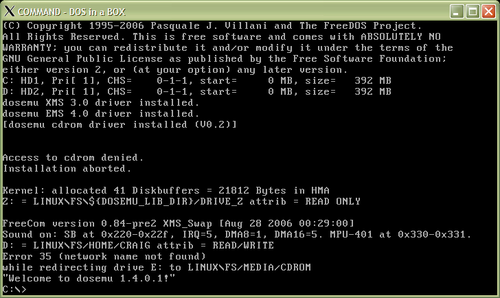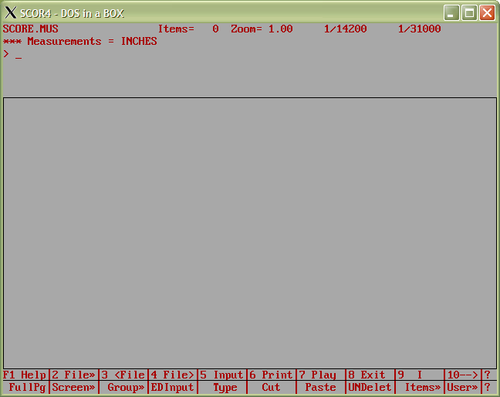Difference between revisions of "SCORE in Linux/X-Windows using Dosemu"
(→Dosemu) |
|||
| Line 5: | Line 5: | ||
Dosemu is a DOS emulator in which SCORE can run. First you will have to install dosemu for your particular operating system and configuration. In Gentoo this is easy to do (as root): | Dosemu is a DOS emulator in which SCORE can run. First you will have to install dosemu for your particular operating system and configuration. In Gentoo this is easy to do (as root): | ||
emerge dosemu | emerge dosemu | ||
| − | On other linux systems, you can try "yum dosemu", "rpm -Uvh dosemu" or "apt-get dosemu", or download and compile the source code manually from the [http://sourceforge.net/projects/dosemu dosemu website]. [http://www.freedos.org/ Freedos] was installed at the same time as dosemu when "emerge dosemu" was run, | + | On other linux systems, you can try "yum dosemu", "rpm -Uvh dosemu" or "apt-get dosemu", or download and compile the source code manually from the [http://sourceforge.net/projects/dosemu dosemu website]. [http://www.freedos.org/ Freedos] was installed at the same time as dosemu when "emerge dosemu" was run, but you may also need to install that before running dosemu. |
Once dosemu is installed, type | Once dosemu is installed, type | ||
dosemu | dosemu | ||
| − | + | This will intialize various files in ~/.dosemu which are needed to run dosemu. Dosemu can be run from a non-X terminal or from x-windows in this setup process. Hopefully you will not get any errors... Here is a screenshot of the dosemu terminal which should appear: | |
[[File:dosemu-startup.png|500px||center]] | [[File:dosemu-startup.png|500px||center]] | ||
| Line 16: | Line 16: | ||
exitemu | exitemu | ||
| − | You should now have a directory called .dosemu in your home directory. Within this directory is a subdirectory called "drive_c". This directory contains files which dosemu calls the C drive when you are running dosemu. Install the SCORE | + | You should now have a directory called .dosemu in your home directory. Within this directory is a subdirectory called "drive_c". This directory contains files which dosemu calls the C drive when you are running dosemu. Install the SCORE program in this subdirectory. If you have SCORE installed on the C: drive in DOS/Windows, then you should not need to change the SCORE preference file. |
=== Running SCORE in Dosemu === | === Running SCORE in Dosemu === | ||
| Line 30: | Line 30: | ||
or | or | ||
scor4\scor4.exe | scor4\scor4.exe | ||
| + | or | ||
| + | c:\scor4\scor4.exe | ||
After the SCORE splash-screen you should see something like this: | After the SCORE splash-screen you should see something like this: | ||
Revision as of 08:24, 22 November 2011
Versions of SCORE compiled for MS-DOS can be run in X-windows (typically on unix or linux computers, but possibly OS X as well) with DOS emulators.
Dosemu
Dosemu is a DOS emulator in which SCORE can run. First you will have to install dosemu for your particular operating system and configuration. In Gentoo this is easy to do (as root):
emerge dosemu
On other linux systems, you can try "yum dosemu", "rpm -Uvh dosemu" or "apt-get dosemu", or download and compile the source code manually from the dosemu website. Freedos was installed at the same time as dosemu when "emerge dosemu" was run, but you may also need to install that before running dosemu.
Once dosemu is installed, type
dosemu
This will intialize various files in ~/.dosemu which are needed to run dosemu. Dosemu can be run from a non-X terminal or from x-windows in this setup process. Hopefully you will not get any errors... Here is a screenshot of the dosemu terminal which should appear:
To exit from dosemu, type:
exitemu
You should now have a directory called .dosemu in your home directory. Within this directory is a subdirectory called "drive_c". This directory contains files which dosemu calls the C drive when you are running dosemu. Install the SCORE program in this subdirectory. If you have SCORE installed on the C: drive in DOS/Windows, then you should not need to change the SCORE preference file.
Running SCORE in Dosemu
To run SCORE in dosemu with linux, you must use X-windows. Most linux systems are running X-windows by default, so this should not be a problem; otherwise, you would type "startx" at the text-only console. In an X-window terminal, you should now type:
dosemu
Alternatively, if you have an X-server running, but are using a non-X terminal, type:
dosemu -X
Then you can run SCORE as usual in DOS:
cd scor4 scor4.exe
or
scor4\scor4.exe
or
c:\scor4\scor4.exe
After the SCORE splash-screen you should see something like this:
Now SCORE can be used as usual. Sometimes the mouse cursor does not appear when starting dosemu. Restarting it solves the problem.
SCORE in batch mode using dosemu
SCORE can be used in an automatic manner with dosemu. In this case the -I option of dosemu can be used to feed keystrokes to SCORE as if you were typing them.
As an example, suppose that you have a file called mytest.pmx which contains ASCII data for a page of music:
8. 1.0 .000 .00 .00 .00 3. 1.0 1.500 17. 1.0 9.500 .00 1.00 1. 1.0 14.300 1.00 10.00 .00 1.0000 1. 1.0 29.275 2.00 10.00 .00 1.0000 1. 1.0 44.250 3.00 10.00 .00 1.0000 1. 1.0 59.225 4.00 10.00 .00 1.0000 14. 1.0 74.200 1.00 1. 1.0 77.700 5.00 10.00 .00 1.0000 1. 1.0 92.675 6.00 10.00 .00 1.0000 1. 1.0 107.650 7.00 20.00 .00 1.0000 1. 1.0 122.625 8.00 20.00 .00 1.0000 14. 1.0 137.600 1.00 1. 1.0 141.100 9.00 20.00 .00 1.0000 1. 1.0 156.075 10.00 20.00 .00 1.0000 1. 1.0 171.050 11.00 20.00 .00 1.0000 1. 1.0 186.025 12.00 20.00 .00 1.0000 14. 1.0 200.000 1.00 2.00
To create an Encapsulated-PostScript file of this music, you can type this command in the unix terminal:
LANG=utf-8 dosemu -X -I 'keystroke "\P1;c:\\scor4\\scor4.exe\r\rre mytest.pmx\rprint\r1 mytest.eps\ry\rg\rexit\ry\rexitemu\r"'
The "LANG=utf-8" may not be necessary, but is used in this case to prevent an error/warning about the character encoding being undefined. The -X option is not necessary if you are starting dosemu within X-windows. The -I option is used to configure dosemu. In this case the -I option is used to pass keystrokes to dosemu. The special characters used in the keystroke string:
\r = carriage return \\ = backspace \P1; = feed 100 characters per second to dosemu. \P20; would feed 5 characters per second (useful for debugging)
Other useful control characters:
\F10; = press the F10 key. \p15; = wait 150 milliseconds before typing next key. \^[ = escape character
The above keystroke string contains the text script necessary to print mytest.pmx into the file mytest.eps:
c:\score\scor4.exe # start SCORE <enter> # skip the splash screen re mytest.pmx # read the macro text print # go to the print menu 1 mytest.eps # save output to mytest.eps y # overwrite mytest.eps (if it exists) g # start printing to file exit # exit from SCORE y # exit without saving any changes exitemu # exit dosemu
You can ajust the script as necessary, adding any special characters such as \r for the enter key.
Here is a short PERL script which converts PMX files or MUS files into EPS files, with multiple PMX/MUS files given as an argument:
#!/usr/bin/perl

